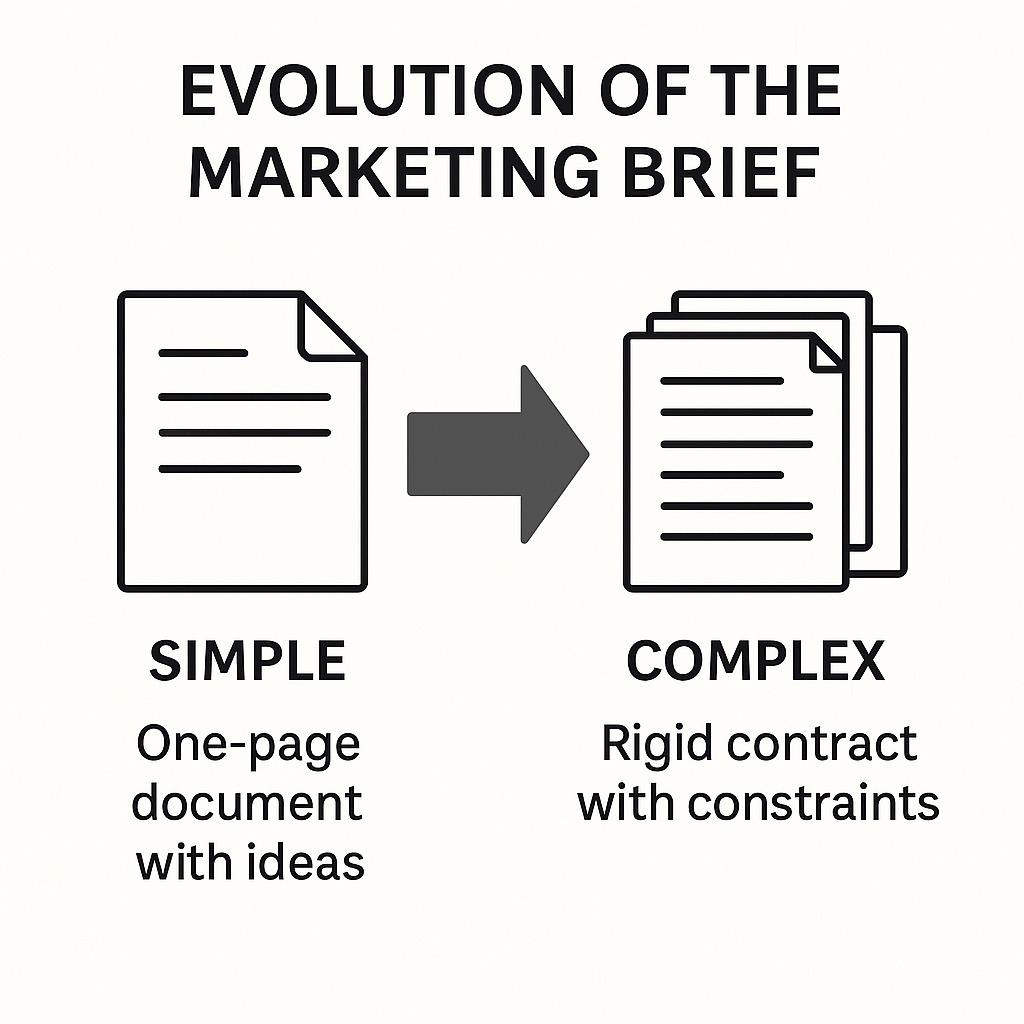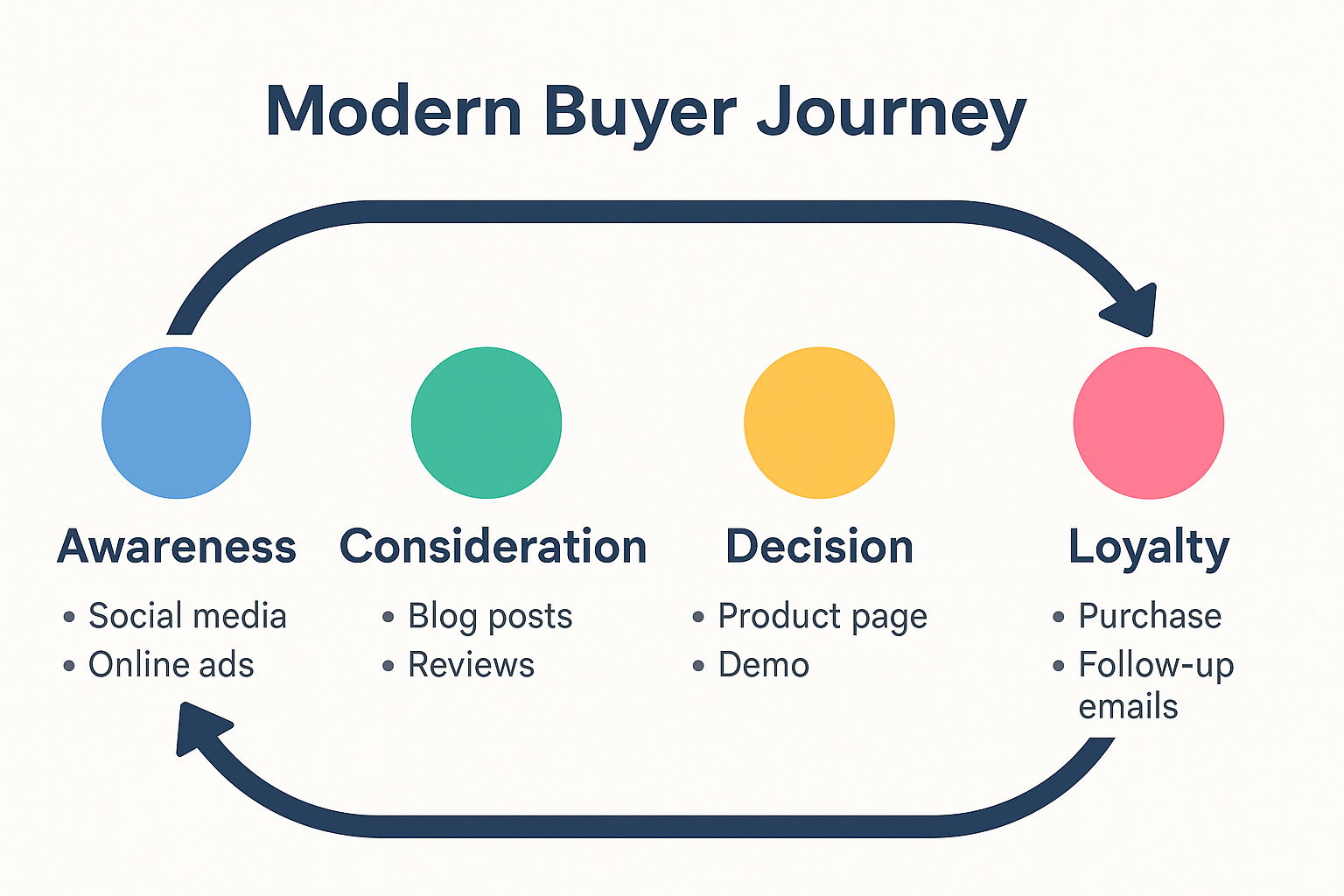Why Traditional Marketing Briefs Fail (and How to Fix Them)
November 20th, 2025
6 min read
By Tom Wardman

Does your marketing brief feel like a creative straitjacket? Are you watching great ideas get watered down through endless revisions and committee reviews?
Traditional marketing briefs have become bureaucratic obstacles rather than creative catalysts. They're killing the very innovation they're meant to inspire, leaving agencies and in-house teams frustrated and clients with predictable, forgettable campaigns.
As someone who has seen dozens of businesses replace these broken systems with agile processes that consistently deliver stronger campaigns, I know from first-hand experience how the right briefing approach can transform marketing from an administrative burden into a creative engine.
Here's what we'll cover: seven ways traditional briefs fail your team, why these problems persist, and the practical steps you can take to fix them.
Why traditional marketing briefs fail creative teams
Traditional marketing briefs fail because they prioritise rigid frameworks over creative exploration, leading to predictable and uninspiring campaigns.
The modern marketing brief has evolved into something its creators never intended. What started as a simple communication tool has morphed into a detailed contract that leaves little room for discovery or breakthrough thinking.
These documents often become more focused on covering legal bases than inspiring creative solutions. Teams spend more time ticking boxes than exploring possibilities. The result? Campaigns that feel safe but fail to cut through the noise.
Most briefs treat creativity like a manufacturing process, assuming you can specify inputs and guarantee outputs. But real innovation happens in the spaces between certainty and possibility, spaces that traditional briefs systematically eliminate. And it's not just the briefs themselves; the processes surrounding them compound the problem.

How approval processes destroy creative momentum in marketing
Extended approval cycles in traditional briefing systems can stretch creative projects from weeks into months, killing the urgency and excitement that fuel breakthrough ideas.
Creative momentum is fragile. When teams get excited about an idea, they need to run with it whilst the energy is hot. Traditional approval processes work against this natural rhythm.
By the time multiple stakeholders have reviewed, revised, and re-approved a brief, market opportunities have often passed. What felt urgent becomes outdated before it launches.
The creative spark that initially drove the project gets extinguished through rounds of feedback and compromise. Teams lose their emotional connection to the work, and what emerges feels manufactured rather than inspired.
Consider this: whilst your brief moves through approval chains, your competitors are already in market with messages that capture the moment your team first identified.
Why committee-driven briefs create watered-down messaging
Marketing briefs developed by committee typically result in generic, risk-averse messaging that appeals to no one whilst trying to satisfy everyone.
When too many voices contribute to a brief's direction, the final output becomes a compromise. Each stakeholder's concerns get folded in, creating messaging that loses its edge and distinctiveness.
The brief becomes a political document rather than a creative catalyst. Teams spend energy navigating internal opinions instead of understanding customer needs.
This committee approach produces briefs that read like they were written by robots programmed to avoid offence. The language becomes corporate speak that customers ignore and creative teams struggle to bring to life.
Strong brands require strong points of view. Committee briefs systematically eliminate anything that might be considered controversial, leaving behind messaging that generates no emotional response whatsoever.
| Traditional Committee Brief | Effective Creative Brief |
|---|---|
| "Increase brand awareness across multiple segments" | "Make busy parents realise we understand their chaos" |
| "Utilise various channels to optimise engagement" | "Meet customers where they actually spend time" |
| "Communicate our value proposition effectively" | "Show don't tell why we're different" |
Creative brief constraints that kill innovation
Overly detailed briefs that dictate specific creative executions leave no room for unexpected discoveries or breakthrough concepts.
Some briefs read like instruction manuals, specifying everything from colour palettes to exact messaging hierarchy. This approach misses the fundamental point of creative development—discovering solutions you couldn't have imagined at the start.
When briefs become prescriptive, they eliminate the possibility of surprise. Creative teams default to safe executions because every decision has been made for them.
The best creative work often comes from unexpected places. A throwaway comment in a brainstorm session becomes the campaign hook. A visual metaphor emerges that nobody planned but perfectly captures the brand essence.
Over-prescribed briefs prevent these moments of discovery. Teams become implementers rather than creators, following instructions instead of solving problems creatively.
Working with agencies and in-house teams has shown me that the most successful campaigns come from briefs that set clear objectives but leave execution methods open for exploration.
How outdated brief templates ignore modern consumer behaviour
Most marketing brief templates were designed for linear, interruption-based advertising and fail to account for today's multi-platform, conversation-driven marketing landscape.
Traditional briefs still structure thinking around single-message, single-medium campaigns. They ask for "the key message" when consumers now expect conversations that evolve across multiple touchpoints.
These legacy formats don't address modern marketing realities like social media virality, user-generated content, or real-time engagement opportunities. They're built for push marketing in a pull-media world.
Today's customers research extensively before buying, often encountering dozens of brand touchpoints. Yet most briefs still think in terms of primary and secondary messages delivered through predetermined channels.
The template sections haven't evolved with consumer behaviour. They still ask for traditional demographics when psychographics and behavioural data matter more. They focus on reach and frequency when engagement and trust drive decisions.

Why siloed briefing processes miss marketing opportunities
Traditional briefs are often created within departmental silos, missing opportunities to create cohesive experiences across touchpoints and channels.
Most briefs get developed within specific departments: digital creates digital briefs, PR develops PR briefs, events teams handle event briefs. Each group optimises for their own channel without considering the customer's complete journey.
This fragmented approach results in disjointed campaigns where social media, PR, and advertising teams work toward conflicting objectives instead of amplifying a unified message.
Customers don't experience brands through departmental silos. They encounter your content on social media, read your PR coverage, see your advertising, and visit your website as part of one continuous experience.
Yet siloed briefing processes create campaigns that feel disconnected. The social media tone differs from the advertising voice. The PR messaging contradicts the sales materials. The event experience doesn't match the digital brand presentation.
Breaking down these silos requires briefing processes that consider the complete customer experience rather than individual channel performance.
The role of fear in restrictive brief development
Many marketing briefs become overly restrictive because stakeholders fear taking creative risks that might reflect poorly on their decision-making.
Risk aversion kills creativity, and nowhere is this more obvious than in brief development. Stakeholders add constraints not because they improve outcomes, but because they provide cover if things go wrong.
This risk-averse mentality creates briefs filled with safety nets and contingencies that ultimately constrain creative teams from developing truly differentiated work.
Fear manifests in different ways throughout the briefing process. Legal teams add disclaimers that complicate simple messages. Senior managers demand multiple concepts so they can choose the safest option. Budget holders require detailed justifications for any unconventional approach.
The irony is that this defensive posture actually increases risk. Safe, predictable campaigns are more likely to be ignored by customers and forgotten by the market. Taking creative risks within strategic boundaries often proves safer than playing it safe.
The most successful campaigns come from briefs that acknowledge uncertainty and give teams permission to explore, fail fast, and iterate based on real market feedback.
How to fix broken briefing systems
The solution lies in replacing rigid brief templates with collaborative discovery sessions that prioritise creative exploration over administrative compliance.
Instead of starting with forms to fill out, begin with conversations to have. Gather the right people in a room and explore the challenge together before documenting anything.
Forward-thinking brands are adopting agile briefing approaches that treat the brief as a living document that evolves with insights rather than a fixed contract that restricts innovation.
This means shifting from briefing as documentation to briefing as dialogue. Start with hypotheses, not certainties. Build in feedback loops that allow the brief to evolve as teams learn more about the challenge and opportunity.
Replace lengthy approval chains with collaborative workshops where stakeholders contribute to solutions rather than just critique them. Give creative teams permission to challenge assumptions and propose alternatives based on their expertise.
The goal isn't to eliminate structure; it's to create frameworks that enable rather than restrict creative thinking. Set clear objectives, provide relevant context, and then trust your teams to find unexpected ways to achieve your goals.
Consider implementing regular brief review sessions where teams can present learnings and request direction changes based on real-world feedback rather than theoretical concerns.
Stop letting broken briefs hold back your team
Broken briefing systems stifle the innovation your business needs to stand out. They turn creative energy into bureaucratic exercises that produce forgettable campaigns.
You've seen the problems: committees that water down messaging, approval chains that kill momentum, over-prescribed constraints that prevent discovery, silos that create disconnected customer experiences, and fear-driven restrictions that eliminate creativity.
These aren't small issues. They're costing you market opportunities whilst your competitors move faster with clearer messages.
Start by exploring agile briefing approaches that treat briefs as conversations rather than contracts. These methods give your team the strategic clarity they need whilst preserving the creative freedom that produces breakthrough work.
I help businesses build marketing systems that consistently attract customers and build trust, without the bureaucratic obstacles that slow everything down. From brief development through to campaign execution, everything works together to connect with customers in meaningful ways.
Let's talk about where you are now and where you want to be.
Topics:





